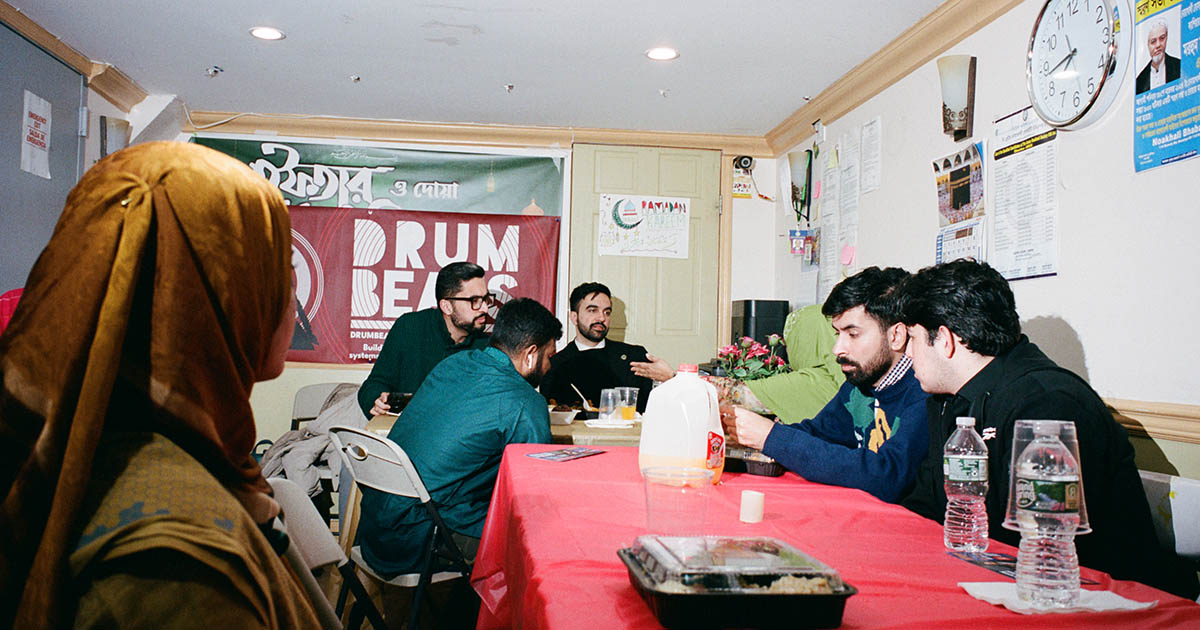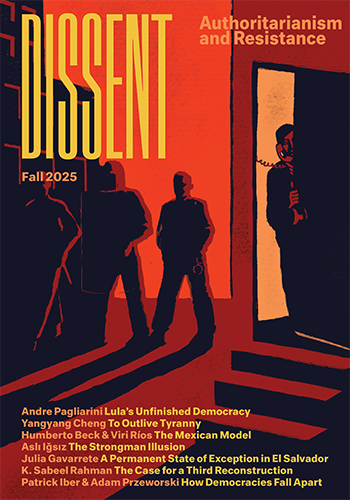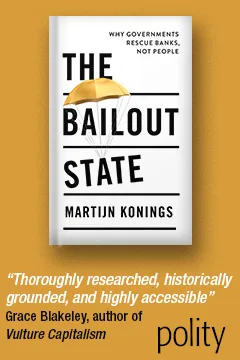Partyism Without the Party
Partyism Without the Party
Zohran Mamdani’s victory was rooted in organizations that took up the base-building and mobilization functions that once fell to parties.

When was the last time being on the left was fun? Even in the best of times, supporting socialism in America can feel like performing a grim duty in the face of almost certain disappointment. The chapter titles in Burnout, Hannah Proctor’s investigation of the emotional landscapes of leftist militancy, are revealing: Melancholia, Nostalgia, Depression, Burnout, Exhaustion, Bitterness, Trauma, Mourning. One of the many virtues of Zohran Mamdani’s remarkable campaign for New York City mayor was that it never felt this way, not even when he was sitting near the bottom of the polls. It was a year-long act of collective joy. Real joy—not the brief sugar high that surged when Kamala Harris replaced Joe Biden at the top of the Democrats’ 2024 ticket. Volunteering for Mamdani never felt like a chore, even when the weather was bad and fewer canvassers showed up for their shift than expected. It was a blast from start to finish, and we didn’t even have to console ourselves with a moral victory. This time, we actually won.
We tend to speak of voting as a civic duty, and of boosting voter participation as a high-minded, “good government” concern. The nature of mass politics, however, has often been anything but staid and responsible. Michael McGerr begins his book The Decline of Popular Politics with a colorful account of a Democratic Party “flag raising” in New Haven in 1876. It was a raucous affair, complete with torchlight parades, street corner speeches, brass bands, fireworks, and rivers of booze courtesy of local party notables. Political spectacle hasn’t gone away, but since the advent of modern communications technology it has become enormously mediated. By contrast, historian Richard Bensel has described the “sheer physicality of voting” and party politics in the nineteenth century. People flocked to the polls, Bensel writes, “simply because they were exciting, richly endowed with ethno-cultural themes of identity, manhood, and mutual recognition of community standing.” It was party politics, in both senses of the word.
This era should not be romanticized. Aside from the fact that only men could vote, the atmosphere of drink-soddened masculinity that pervaded election campaigns kept most women away even when it did not descend into partisan and racial violence. Even so, it is hard not to agree with political scientists Daniel Schlozman and Sam Rosenfeld that America’s early mass parties “bequeathed a genuinely popular and participatory” culture whose “promise still haunts American politics.”
Much has been made of Mamdani’s extremely effective use of social media, short-form video, and other digital formats that speak to the younger and disengaged voters many other campaigns struggle to reach. There’s no doubt this was a major ingredient in the campaign’s success; historically high rates of participation among Gen Z and newly registered voters testify to its effectiveness. But the sheer physicality of the Mamdani campaign, and the ways it used digital media to bring people together offline, has been underrated.
Consider the citywide scavenger hunt in August. A call went out over social media on a Saturday night, and thousands of people showed up the next morning to race around seven stops across the boroughs, each one connected to the city’s history. Disgraced incumbent mayor Eric Adams denounced the frivolity: “I’m sure a scavenger hunt was fun for the people with nothing better to do. . . . Mamdani is trying to turn our city into the Squid Games.” One competitor offered a different perspective: “I think actually trying to have fun in politics and do a little bit of a community building exercise, a way to actually learn about our city—I’ve never known another politician to do it.”
The scavenger hunt was just one example of the campaign’s popular and participatory culture. So much of the campaign was in public and in person: mass rallies, a walk through the entire length of Manhattan, unannounced appearances at clubs and concerts, a 100,000-strong army of volunteers who braved countless walk-ups to knock over 1 million doors. From early spring through November’s general election, the campaign assumed the scale and spirit of a social movement, or a Knicks playoff run. There was a palpable buzz around the city—not just in what New York electoral data maven Michael Lange termed the “Commie Corridor” neighborhoods, populated by young college-educated leftists, but in Little Pakistan, Little Bangladesh, Parkchester, and other places where nary a New Yorker tote bag can be found.
When the polls closed, more than 2 million voters had cast their ballots, the highest turnout in a New York City mayoral election since 1969. More than 1 million voters, just over half the electorate, voted for Mamdani. At the same time, over 850,000 voted for Andrew Cuomo, who successfully consolidated many Republican voters behind his second-effort bid to return to public office. Another 146,000 voted for the official Republican candidate, the perennial also-ran Curtis Sliwa.
Mamdani’s shockingly decisive win in the Democratic primary had been powered by his core constituencies: younger voters, college-educated renters, and South Asian and Muslim voters, many of whom participated in the electoral process for the first time. He carried these constituencies with him into the general election, but he may have struggled to win the final contest without rallying large numbers of working-class Black and Hispanic voters too. As Lange has shown, the areas that shifted most strongly toward Mamdani from the primary to the general election were Black and Hispanic neighborhoods in the Bronx, Brooklyn, and Queens. Many Black and Hispanic voters under forty-five were already in Mamdani’s column in the primary, but his numbers then were far lower among their parents and grandparents. After securing the Democratic nomination, his campaign made inroads by building relationships with Black church congregations and community organizations, as well as labor unions with disproportionately Black and Hispanic memberships. By cobbling these disparate constituencies together in the general election, Lange concluded, Mamdani successfully renewed the promise of the Rainbow Coalition for the twenty-first century.
Not By Bread-and-Butter Alone
Explaining how Mamdani did this has become something of a Rorschach test for pundits. Much of the commentary has focused on his campaign’s affordability agenda, which targeted the city’s cost-of-living crisis through proposals for freezing rents, eliminating fares on city buses, and implementing universal child care, among others. While Mamdani’s emphasis on affordability was necessary for securing the victory, and his economic proposals were popular across his constituencies, he would not have been able to mobilize the coalition he did on the strength of bread-and-butter appeals alone. Mamdani’s unequivocal stances on “non-economic” questions like the genocide in Gaza or the ICE raids terrorizing immigrant communities built trust among precisely the people he needed to join his volunteer army or turn out to vote for the first time.
Support for Palestine dovetailed with Mamdani’s vocal opposition to the Trump administration’s assault on immigrants, which came together in an impromptu confrontation with Trump’s “border czar” Tom Homan last March. A video of the encounter, in which Mamdani challenged Homan over the illegal detention of Palestinian solidarity activist Mahmoud Khalil, circulated widely on social media and in immigrant communities. All of this helped Mamdani link his economic program with opposition to the president’s authoritarian lurch. In doing so, he appealed to immigrant voters worried about both ICE raids and making the rent, as well as voters who want their representatives to stand up to masked federal agents snatching people off the streets and whisking them away in unmarked cars. Moreover, Mamdani’s identity as a Muslim of South Asian descent undoubtedly activated demobilized voters excited by the idea of seeing someone like them in Gracie Mansion. The historic turnout surge that swept Muslim and South Asian neighborhoods in the outer boroughs is inseparable from Mamdani’s faith, his cultural fluency, and his outspoken defense of fellow Muslims against the Cuomo campaign’s Islamophobic bigotry.
The New York City chapter of the Democratic Socialists of America (NYC-DSA) has received a lot of credit for Mamdani’s victory, and rightfully so. Mamdani is a DSA member, as are his chief of staff, field director, and other key advisers. The campaign’s field leads, who organized canvassing shifts, were disproportionately members (I co-led a weekly canvass in my Brooklyn neighborhood during the primary). But organizations rooted in South Asian and Muslim communities deserve their fair share of the credit, including Desis Rising Up and Moving (DRUM) Beats, the Muslim Democratic Club of New York, Bangladeshi Americans for Political Progress, and grassroots affinity groups like Pakistanis for Zohran and Bangladeshis for Zohran. The mobilization of these communities transformed the electorate and helped Mamdani offset Cuomo’s strength in neighborhoods that shifted sharply to the former governor in the general election.
There are nearly 1 million Muslims in New York, but until Mamdani’s campaign they were a sleeping giant in local politics. Roughly 350,000 Muslims were registered, but only 12 percent of registered Muslims turned out to vote in the 2021 mayoral election. Mamdani’s campaign turned this dynamic completely on its head. DRUM Beats, which has organizing bases in the Bronx, Brooklyn, and Queens spanning a range of South Asian and Indo-Caribbean diasporic communities, played a key role. Their organizers are committed and tenacious, and many of them are women. “We’re like a gang,” the group’s organizing director Kazi Fouzia told a Politico reporter last summer. “When we go to any shop, people just move aside and say, ‘Oh my god. The DRUM leaders are here. The DRUM women are here.’” When Mamdani recognized “every New Yorker in Kensington and Midwood” in his victory speech, he had in mind the scores of aunties who ran themselves ragged knocking doors, sending texts, and making phone calls.
In their post-election analysis of the voting data, DRUM Beats detailed an enormous increase in turnout in the communities they organize. Based on Board of Elections data and their own models, they estimated that from 2021 to 2025 South Asian turnout exploded from 15.3 percent to nearly 43 percent, while Muslim turnout went from barely 15 percent to over 34 percent. While representing just 7 percent of New York’s registered voters, they accounted for an estimated 15 percent of actual voters in the general election. Nearly half of the city’s registered Bangladeshi and Pakistani American voters participated in the election, outpacing the overall participation rate of roughly 42 percent. This historic development didn’t materialize out of thin air. Mamdani’s faith, identity, and raw talent certainly didn’t hurt, but people on the ground have been quietly building civic infrastructure in these neighborhoods. In his assessment of the South Asian surge, electoral strategist Waleed Shahid noted that the places with the biggest gains were precisely “the places where DRUM Beats and allied organizers have spent years knocking doors, translating ballot measures, convening tenant meetings in basement prayer rooms, and building lists through WhatsApp groups and WhatsApp rumors alike.” I had the good fortune of getting to know some of these organizers during the campaign. Their capacity to mobilize working-class immigrants who had been overlooked for too long is formidable, and Mamdani’s victory cannot be explained without it.
Mamdani claimed the legacy of Fiorello La Guardia and Vito Marcantonio in the campaign’s final days, and the historical resonances ran deep. Shahid drew a parallel between the current moment and earlier realignments in the city’s political history “when groups written off as threatening or foreign became disciplined voting blocs: Irish Catholics moving from despised outsiders to Tammany’s core; Jewish and Italian workers turning the Lower East Side into a labor/socialist stronghold.” I am a product of New York’s twentieth-century Italian American diaspora myself. In rooms full of South Asian aunties for Zohran, wearing headscarves and plying everyone with plates of food, I saw people who in a different time could have been my own relatives stumping for the Little Flower, the legendary figure who was once told New York wasn’t ready for an Italian mayor. Turns out it was ready for an Italian mayor then, and it’s ready for a Muslim mayor now.
A Test for Partyism
Donald Trump’s return to the presidency set off a war of white papers on Democratic Party electoral strategy that shows few signs of a ceasefire. There are a variety of strategic prescriptions, but many of them fall into two broad and infelicitously named camps: popularists and deliverists. Popularists tend to hail from the party’s moderate wing, but not always. There is a leftist variety of popularism, for example, that finds expression in projects like the Center for Working-Class Politics. Ezra Klein has offered perhaps the clearest definition of the popularist persuasion: “Democrats should do a lot of polling to figure out which of their views are popular and which are not popular, and then they should talk about the popular stuff and shut up about the unpopular stuff.” Deliverism, by contrast, focuses less on campaigning and more on governing. As Matt Stoller summarized it in a tweet: “deliver and it helps you win elections. Don’t deliver and you lose.” When Democrats are in power, they should implement bold policies that improve people’s lives and then reap the rewards from a satisfied electorate.
There is an element of “duh, of course” to both schools of thought, but the weaknesses are easy to spot. Popularism seeks to mirror the current state of public opinion for the sake of electoral success, but public opinion is malleable and sometimes quite fickle. One need only look at the wildly fluctuating data on immigration attitudes since the 2024 election to see how quickly chasing public opinion can become a fool’s errand. Deliverism, by contrast, presumes “a linear and direct relationship between economic policy and people’s political allegiances,” as Deepak Bhargava, Shahrzad Shams, and Harry Hanbury put it. But that’s not typically how real people operate. The Biden administration was, in many respects, an experiment in deliverism that failed to deliver. It implemented policies that brought tangible benefits to millions of people but still couldn’t prevent Trump from returning to the White House.
The limitations of both popularism and deliverism have opened space for a new school of thought, one that tackles strategic electoral questions from a different angle (but also has a terrible name): partyism. The political scientist Henry Farrell has usefully summarized its premises: the Democratic Party’s fundamental problem is not its ideological positioning but the fact that it’s not a political party in any real sense. “If Democrats want to succeed,” Farrell writes, they need to “build up the Democratic party as a coherent organization that connects leaders to ordinary people.” In their book The Hollow Parties, Daniel Schlozman and Sam Rosenfeld trace how the Democratic and Republican parties alike have been transformed into rival “blobs” of consultants, donors, strategists, and interest groups. Their critique has been influential, and it has informed a spate of proposals for turning the Democratic Party into a network of civic institutions that engages voters between elections and mediates effectively between leaders and the base.
The Mamdani campaign was arguably the first major test of the partyist approach in practice. While there is no indication that campaign leaders and strategists consciously appropriated these ideas, it is not difficult to see the affinities between them. The campaign brought new and disengaged voters into the fold through novel activities like the scavenger hunt and the Cost of Living Classic, a citywide soccer tournament held in Coney Island. Its sinew and muscle came not from TikTok or Instagram, but rooted civic organizations like NYC-DSA, DRUM Beats, United Auto Workers Region 9A, and the mosques, synagogues, and churches that opened their doors to the candidate. Even four of the five Democratic Party county committees in the city endorsed him, despite their historic wariness of insurgent candidates from the democratic socialist left (only the Queens county committee, a stronghold of dead-end Cuomo supporters, snubbed him). Mamdani’s victory was based, to a significant extent, on organizations with real members who engage in meaningful civic and political activity.
Of all the organizations listed above, however, the least important by far are the official bodies of the Democratic Party. The Mamdani campaign may have embodied an emergent partyist politics, but this is a partyism without the party. NYC-DSA’s electoral strategy, for example, is grounded in the concept of the “party surrogate” first proposed by Jacobin’s Seth Ackerman and developed further by the political scientist Adam Hilton and others. Given the daunting odds of successfully establishing any new party, Hilton proposes a network of chapter-based organizations “oriented toward building a base within working-class communities and labor unions that can also act as an effective independent pressure group on the Democratic Party.” This is precisely what Mamdani and other socialist candidates have done. Primary voters—not party organizations—decide candidate nominations, which radically reduces the incentives for transforming those organizations. Why fill in the hollow parties when you can do much the same thing outside of them?
For now, at least, partyist projects like the one that catapulted Mamdani into political stardom will continue to gestate outside of any formal party organization. The NYC-DSA chapter has doubled in size to 13,000 members since 2024, and that number will likely continue to grow. Organizers have established a new organization called Our Time that is focused on mobilizing campaign volunteers in support of Mamdani’s agenda after he is sworn into office. NYC-DSA, DRUM Beats, labor unions, tenant groups, and other organizations that endorsed Mamdani during the campaign have established a formal coalition called the People’s Majority Alliance to do much the same thing at the organizational leadership level. So it seems unlikely that Mamdani’s coalition will demobilize the way Barack Obama’s did after 2008. These are independent organizations, constituted outside of official Democratic Party institutions, that assume the base-building and mobilization functions a party would carry out directly in most other political systems. This is the form popular and participatory politics takes in the age of hollow parties, raising the possibility that a lost culture once sustained by precinct captains, ward heelers, and saloon keepers could be reborn in a new way.
Rolling back MAGA will require speaking to popular needs and aspirations and delivering on them. It will also require developing our capacities to work together in a spirit of democratic cooperation and public exuberance. The Mamdani campaign laid the foundations for this in one city, but here and elsewhere much more reconstruction remains to be done.
Chris Maisano is a trade unionist and Democratic Socialists of America activist. He lives in Brooklyn, New York.






